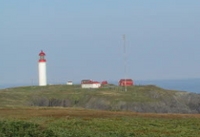From 17th and 18th century fisherman, whalers, pirates and smugglers, to telegraph lines and early transatlantic wireless, the history of Cape Race is fascinating. Jutting into the sea at the most southeasterly point in Newfoundland, it naturally became a call-point to all North Atlantic shipping. The Cape is a National Historic site. The first lighthouse was built there in 1856, and was replaced several times.
After a 20 km drive along a dirt road and across barren headlands to its fog-shrouded cliffs and lighthouse, you will appreciate rain gear and warm clothing. The lighthouse sits atop formidable 40-meter cliffs, and has an average of 158 days of fog per year.
One piece of local advice to visitors reads: “you should start early because you do not want to be caught on that windswept peninsula after dark.” However, word has it that you might be invited in by the lighthouse keeper for a cup of tea.
In 1861a London paper reported, “From this lonely rock, standing out in the Atlantic amid fogs and storms, European news is flashed to the most distant parts of America…..(it) has become as well known and its name as familiar as is that of New York or Boston.”
Cape Race was the site of the first North American Marconi wireless station. A replica station was built for its centennial in 2001. In 1912, distress signals from the sinking Titanic were received by the wireless operator at Cape Race, and broadcast from there to the rest of the world.

In 1904, the first wireless station in Newfoundland was built at Cape Race.